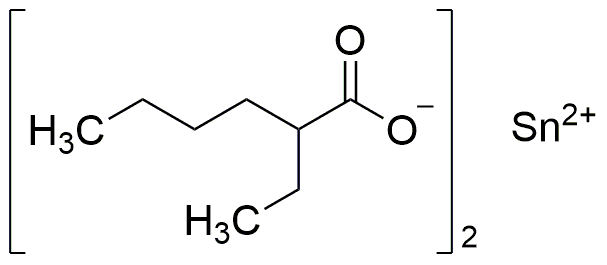Tin(II) 2-ethylhexanoate is widely utilized in research focused on:
- Polymer Production: This compound acts as a catalyst in the production of polyurethanes and other polymers, enhancing the efficiency of the manufacturing process and improving product quality.
- Coatings and Sealants: It is used in formulating high-performance coatings and sealants, providing excellent adhesion and durability, which is crucial in construction and automotive industries.
- Stabilizers in Plastics: Tin(II) 2-ethylhexanoate serves as a stabilizer in PVC and other plastics, helping to maintain their integrity and extend their lifespan, making it valuable in packaging and consumer goods.
- Adhesives: This compound is incorporated into adhesive formulations, improving bond strength and resistance to environmental factors, which is essential for various industrial applications.
- Research Applications: In laboratories, it is used as a reagent in organic synthesis, allowing researchers to develop new materials and compounds with specific properties.
General Information
Properties
Safety and Regulations
Applications
Tin(II) 2-ethylhexanoate is widely utilized in research focused on:
- Polymer Production: This compound acts as a catalyst in the production of polyurethanes and other polymers, enhancing the efficiency of the manufacturing process and improving product quality.
- Coatings and Sealants: It is used in formulating high-performance coatings and sealants, providing excellent adhesion and durability, which is crucial in construction and automotive industries.
- Stabilizers in Plastics: Tin(II) 2-ethylhexanoate serves as a stabilizer in PVC and other plastics, helping to maintain their integrity and extend their lifespan, making it valuable in packaging and consumer goods.
- Adhesives: This compound is incorporated into adhesive formulations, improving bond strength and resistance to environmental factors, which is essential for various industrial applications.
- Research Applications: In laboratories, it is used as a reagent in organic synthesis, allowing researchers to develop new materials and compounds with specific properties.
Documents
Safety Data Sheets (SDS)
The SDS provides comprehensive safety information on handling, storage, and disposal of the product.
Product Specification (PS)
The PS provides a comprehensive breakdown of the product’s properties, including chemical composition, physical state, purity, and storage requirements. It also details acceptable quality ranges and the product's intended applications.
Certificates of Analysis (COA)
Search for Certificates of Analysis (COA) by entering the products Lot Number. Lot and Batch Numbers can be found on a product’s label following the words ‘Lot’ or ‘Batch’.
*Catalog Number
*Lot Number
Certificates Of Origin (COO)
This COO confirms the country where the product was manufactured, and also details the materials and components used in it and whether it is derived from natural, synthetic, or other specific sources. This certificate may be required for customs, trade, and regulatory compliance.
*Catalog Number
*Lot Number
Safety Data Sheets (SDS)
The SDS provides comprehensive safety information on handling, storage, and disposal of the product.
DownloadProduct Specification (PS)
The PS provides a comprehensive breakdown of the product’s properties, including chemical composition, physical state, purity, and storage requirements. It also details acceptable quality ranges and the product's intended applications.
DownloadCertificates of Analysis (COA)
Search for Certificates of Analysis (COA) by entering the products Lot Number. Lot and Batch Numbers can be found on a product’s label following the words ‘Lot’ or ‘Batch’.
*Catalog Number
*Lot Number
Certificates Of Origin (COO)
This COO confirms the country where the product was manufactured, and also details the materials and components used in it and whether it is derived from natural, synthetic, or other specific sources. This certificate may be required for customs, trade, and regulatory compliance.

